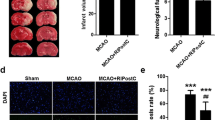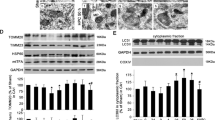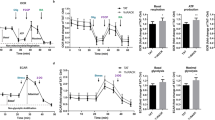Abstract
Ischemic preconditioning (IPC) represents the phenomenon of CNC adaptation, which results in increased tolerance of CNS to lethal ischemia. Brain ischemia/reperfusion (IRI) initiates a catastrophic cascade in which many subcellular organelles play an important role. The Golgi apparatus, which is a part of secretory pathways (SP), represents the Ca2+ store and regulates secretion of proteins for growth/reorganization of neuronal circuit by secretory Ca2+ATPases (SPCA1). The purpose of this study is to evaluate the effect of IRI and preconditioning on SPCA1 gene expression and oxidative damage after 4-vessel occlusion for 15 min and after being exposed to different reperfusion periods. Rats were preconditioned by 5 min of sub-lethal ischemia and 2 days later, 15 min of lethal ischemia was induced. Our experiments conclusively showed IRI-induced depression of SPCA activity and lipo- and protein oxidation in rat hippocampal membranes. IRI also activates the induction of SPCA1 gene expression in later reperfusion periods. IPC partially suppresses lipo- and protein oxidation in hippocampal membranes and leads to partiall rovery of the ischemic-induced depression of SPCA activity. In addition, IPC initiates earlier cellular response to the injury by the significant elevation of mRNA expression to 142% comparing to 1 h of corresponding reperfusion and to 11% comparing to 24 h of corresponding reperfusion, respectively. Similar patterns were observed on the translational level by Western blot analysis. Our results indicate the specific SPCA1 expression pattern in ischemic hippocampus. It also shows that the SPCA expression and the post-translational changes induced by ischemia are modulated by the IPC. This might serve to understand the molecular mechanisms involved in the structural integrity and function of the SP after ischemic challenge. It also suggests that there is a correlation of SPCA function with the role of SP in the response to pre-ischemic challenge.


Similar content being viewed by others
References
Burda J, Hrehorovska M, García BL, Danielisova V, Cízkova D, Burda R, Nemethova M, Fando JL, Salinas M (2003) Role of protein synthesis in the ischemic tolerance acquisition induced by transient forebrain ischemia in the rat. Neurochem Res 28:1237–1243. doi:10.1023/A:1024232513106
Burda J, Matiasová M, Gottlieb M, Danielisová V, Némethová M, Garcia L, Salinas M, Burda R (2005) Evidence for a role of second pathophysiological stress in prevention of delayed neuronal death in the hippocampal CA1 region. Neurochem Res 30:1397–1405. doi:10.1007/s11064-005-8510-z
Danielisová V, Némethová M, Gottlieb M, Burda J (2005) Changes of endogenous antioxidant enzymes during ischemic tolerance acquisition. Neurochem Res 30:559–565. doi:10.1007/s11064-005-2690-4
Das DK, Maulik N (1994) Antioxidant effectiveness in ischemia-reperfusion tissue injury. Methods Enzymol 233:601–610. doi:10.1016/S0076-6879(94)33063-8
Dousset N, Ferretti G, Taus M, Valdiguie P, Curatola G (1994) Fluorescence analysis of lipoprotein peroxidation. Methods Enzymol 233:459–469. doi:10.1016/S0076-6879(94)33052-2
Endres M, Engelhardt B, Koistinaho J, Lindvall O, Meairs S, Mohr JP, Planas A, Rothwell N, Schwaninger M, Schwab ME, Vivien D, Wieloch T, Dirnagl U (2008) Improving outcome after stroke: overcoming the translational roadblock. Cerebrovasc Dis 25:268–278. doi:10.1159/000118039
Gidday JM (2006) Cerebral preconditioning and ischaemic tolerance. Nat Rev Neurosci 7(6):437–448. doi:10.1038/nrn1927
Giulivi C, Davies KJ (1994) Dityrosine: a marker for oxidatively modified proteins and selective proteolysis. Methods Enzymol 233:363–371. doi:10.1016/S0076-6879(94)33042-5
Gonatas NK, Stieber A, Gonatas JO (2006) Fragmentation of the Golgi apparatus in neurodegenerative diseases and cell death. J Neurol Sci 246:21–30. doi:10.1016/j.jns.2006.01.019
Hicks SW, Machamer CE (2005) Golgi structure in stress sensing and apoptosis. Biochim Biophys Acta 1744:406–414. doi:10.1016/j.bbamcr.2005.03.002
Kawada H, Nishiyama C, Takagi A, Tokura T, Nakano N, Maeda K, Mayuzumi N, Ikeda S, Okumura K, Ogawa H (2005) Transcriptional regulation of ATP2C1 gene by Sp1 and YY1 and reduced function of its promoter in Hailey-Hailey disease keratinocytes. J Invest Dermatol 124:1206–1214. doi:10.1111/j.0022-202X.2005.23748.x
Lehotský J, Kaplan P, Racay P, Matejovicova M, Drgova A, Mezesova V (1999) Membrane ion transport systems during oxidative stress in rodent brain: protective effect of stobadine and other antioxidants. Life Sci 65:1951–1958. doi:10.1016/S0024-3205(99)00454-3
Lehotský J, Kaplan P, Matejovicova M, Murín R, Racay P, Raeymaekers L (2002a) Ion transport systems as targets of free radicals during ischemia/reperfusion injury. Gen Physiol Biophys 21:31–37
Lehotský J, Kaplán P, Murín R, Raeymaekers L (2002b) The role of plasma membrane Ca2+ pumps (PMCAs) in pathologies of mammalian cells. Front Biosci 7:d53–d84. doi:10.2741/lehotsky
Lehotský J, Murín R, Strapková A, Uríková A, Tatarková Z, Kaplán P (2004) Time course of ischemia/reperfusion-induced oxidative modification of neural proteins in rat forebrain. Gen Physiol Biophys 23(4):401–415
Lipton P (1999) Ischemic cell death in brain neurons. Physiol Rev 79:1431–1568
Lowry OH, Rosebrough NJ, Farr AL, Randall RJ (1951) Protein measurement with the Folin phenol reagent. J Biol Chem 193:265–275
Maag RS, Hicks SW, Machamer CE (2003) Death from within: apoptosis and the secretory pathway. Curr Opin Cell Biol 15:456–461. doi:10.1016/S0955-0674(03)00075-9
Michelangeli F, Ogunbayo OA, Wootton LL (2005) A plethora of interacting organellar Ca2+ stores. Curr Opin Cell Biol 17:135–140. doi:10.1016/j.ceb.2005.01.005
Murin R, Verleysdonk S, Raeymaekers R, Kaplan P, Lehotsky J (2006) Distribution of secretory pathway Ca2+ ATPase (SPCA1) in neuronal and glial cell cultures. Cell Mol Neurobiol 26:1355–1365. doi:10.1007/s10571-006-9042-z
Obrenovitch TP (2008) Molecular physiology of preconditioning-induced brain tolerance to ischemia. Physiol Rev 88:211–247. doi:10.1152/physrev.00039.2006
Okunade GW, Miller ML, Azhar M, Andringa A, Sanford LP, Doetschman T, Prasad V, Shull GE (2007) Loss of the Atp2c1 secretory pathway 22 Ca2+-ATPase (SPCA1) in mice causes Golgi stress, apoptosis, and midgestational death in homozygous embryos and squamous cell tumors in adult heterozygote. J Biol Chem 282:26517–26527. doi:10.1074/jbc.M703029200
Parsons JT, Churn SB, DeLorenzo RJ (1999) Global ischemia-induced inhibition of the coupling ratio of calcium uptake and ATP hydrolysis by rat whole brain microsomal Mg(2+)/Ca(2+) ATPase. Brain Res 834:32–41. doi:10.1016/S0006-8993(99)01504-8
Pulsinelli WA, Brierley JB, Plum F (1982) Temporal profile of neuronal damage in a model of transient forebrain ischemia. Ann Neurol 11(5):491–498. doi:10.1002/ana.410110509
Sepúlveda MR, Berrocal M, Marcos D, Wuytack F, Mata AM (2007) Functional and immunocytochemical evidence for the expression and localization of the secretory pathway Ca(2+)-ATPase isoform 1 (SPCA1) in cerebellum relative to other Ca(2+) pumps. J Neurochem 103:1009–1018. doi:10.1111/j.1471-4159.2007.04794.x
Sepúlveda MR, Marcos D, Berrocal M, Raeymaekers L, Mata AM, Wuytack F (2008) Activity and localization of the secretory pathway Ca2+-ATPase isoform 1 (SPCA1) in different areas of the mouse brain during postnatal development. Mol Cell Neurosci 38:461–473. doi:10.1016/j.mcn.2008.02.012
Shi H, Liu KJ (2007) Cerebral tissue oxygenation and oxidative brain injury during ischemia and reperfusion. Front Biosci 12:1318–1328. doi:10.2741/2150
Sivonová M, Kaplán P, Duracková Z, Dobrota D, Drgová A, Tatarková Z, Pavlíková M, Halasová E, Lehotský J (2008) Time course of peripheral oxidative stress as consequence of global ischaemic brain injury in rats. Cell Mol Neurobiol 28(3):431–441. doi:10.1007/s10571-007-9246-x
Strosznajder R, Gadamski R, Walski M (2005) Inhibition of poly(ADP-ribose) polymerase activity protects hippocampal cells against morphological and ultrastructural alteration evoked by ischemia-reperfusion injury. Folia Neuropathol 43:156–165
Urban P, Pavlíková M, Sivonová M, Kaplán P, Tatarková Z, Kaminska B, Lehotský J (2009) Molecular analysis of endoplasmic reticulum stress response after global forebrain ischemia/reperfusion in rats: effect of neuroprotectant simvastatin. Cell Mol Neurobiol 29:181–192. doi:10.1007/s10571-008-9309-7
Uríková A, Babusíková E, Dobrota D, Drgová A, Kaplán P, Tatarková Z, Lehotský J (2006) Impact of Ginkgo Biloba Extract EGb 761 on ischemia/reperfusion-induced oxidative stress products formation in rat forebrain. Cell Mol Neurobiol 26:1343–1353. doi:10.1007/s10571-006-9030-3
Valko M, Leibfritz D, Moncol J, Cronin MT, Mazur M, Telser J (2007) Free radicals and antioxidants in normal physiological functions and human disease. Int J Biochem Cell Biol 39:44–84. doi:10.1016/j.biocel.2006.07.001
Van Baelen K, Dode L, Vanoevelen J, Callewaert G, De Smedt H, Missiaen L, Parys JB, Raeymaekers L, Wuytack F (2004) The Ca2+/Mn2+ pumps in the Golgi apparatus. Biochim Biophys Acta 1742:103–112. doi:10.1016/j.bbamcr.2004.08.018
Wootton LL, Argent CC, Wheatley M, Michelangeli F (2004) The expression, activity and localisation of the secretory pathway Ca2+-ATPase (SPCA1) in different mammalian tissues. Biochim Biophys Acta 1664:189–197. doi:10.1016/j.bbamem.2004.05.009
Xiang M, Mohamalawari D, Rao R (2005) A novel isoform of the secretory pathway Ca2+, Mn(2+)-ATPase, hSPCA2, has unusual properties and is expressed in the brain. J Biol Chem 280:11608–11614. doi:10.1074/jbc.M413116200
Acknowledgments
This study was supported by Grants VEGA 0049/09, MVTS-COST B30, from the Ministry of Education of the Slovak Republic, UK-55-15/07 from Ministry of Health of the Slovak republic, and VVCE 0064-07.
Author information
Authors and Affiliations
Corresponding author
Electronic supplementary material
Below is the link to the electronic supplementary material.
Rights and permissions
About this article
Cite this article
Pavlíková, M., Tatarková, Z., Sivoňová, M. et al. Alterations Induced by Ischemic Preconditioning on Secretory Pathways Ca2+-ATPase (SPCA) Gene Expression and Oxidative Damage After Global Cerebral Ischemia/Reperfusion in Rats. Cell Mol Neurobiol 29, 909–916 (2009). https://doi.org/10.1007/s10571-009-9374-6
Received:
Accepted:
Published:
Issue Date:
DOI: https://doi.org/10.1007/s10571-009-9374-6




